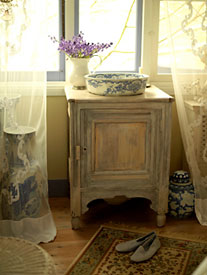Narrative Essay for College: A Visit to the Past
I wrote this narrative essay for a U.S. history course (also known as a personal essay). I asked the professor, beforehand, if I could write a creative essay, rather than the usual suspects that professors usually anticipate. She was thrilled that I wanted to personalize the experience of visiting a historical landmark in New York City, The Lower East Side Tenement House.
The assignment: Visit any historical place and write about it.
—–
 The Lower East Side Tenement House in New York City was an eye-opening experience. Upon arrival, a group of us entered through a long, narrow hallway with brown, charred walls that were laced with intricate gold detail. As I turned my head upward, I could see flakes of chipped paint dangling from the ceiling, which concerned me. In 1916, the dangers of lead paint hadn’t been revealed yet, and as per instructed, the ceiling and walls were mostly in their original condition.
The Lower East Side Tenement House in New York City was an eye-opening experience. Upon arrival, a group of us entered through a long, narrow hallway with brown, charred walls that were laced with intricate gold detail. As I turned my head upward, I could see flakes of chipped paint dangling from the ceiling, which concerned me. In 1916, the dangers of lead paint hadn’t been revealed yet, and as per instructed, the ceiling and walls were mostly in their original condition.
Slowly we proceeded down the tapered hallway and knocked on the door of the Confino family. When little Victoria answered the door, we were instructed by the tour-guide to play the roles of Jewish immigrants who had just arrived from Europe–inquiring to see if Victoria could hold us up for the evening. But by daybreak, we were to seek assistance at one of the settlement houses to help us find permanent residence.
After looking us over with a suspicious eye, Victoria decided to let us in, quickly giving us a tour of the tiny three-room apartment in which she and her family of 10 shared. The floorboard squeaked beneath my feet, and a cloud of soot smothered my nostrils as I stepped into the archival apartment. I was astounded that 10 people could share such small living quarters and promptly asked her where we were to sleep for the night. She put down her head, in what I thought was shame, and pointed to the dusty slabs of a wooden floor. We, the group, looked at each other in complete silence, but you could hear the cries from the bottom of our breaths. Victoria hastily intervened and pulled thick blankets down from a shelf. “See, it’s not so bad,” she said with her thick accent. The blank stares on our faces gradually turned into smiles, and quieted the cries that bellowed from underneath our breaths.
Once we got settled in, I noticed undergarments with lace trimming hanging on a clothesline in the kitchen. I thought that was a little too forthcoming, especially with guests in the house, but there was no bathroom within the apartment to accommodate such intimate needs–and no privacy from family members.
Victoria Confino was 14-years-old, the daughter to Rachel and Abraham Confino, and had been living at 97 Orchard Street for three years. Her family fled to the United States from Kastoria, Greece to keep her brother, Joseph, from being summoned to the army and led to the Balkan War. The family spoke a 15th century Spanish and Hebrew dialect called “Ladino” and had a hard time with the Eastern European Jews in the neighborhood who spoke a different tongue; also, their ways of life and dress were culturally different.
While in character the entire time, Victoria walked us into the cramped living room and sat us down all in a row as if she were doing a cattle-count. We had our luggage meagerly stuffed with clothes that Victoria felt were unsuitable and motioned us to the bedroom to try on new garments. I lifted a tattered white dress from the wooden armoire and slipped into it, feet first. I couldn’t imagine such a humbling piece of fabric hanging from my torso. I internally questioned whether the fabric was made of all natural fibers, since money spent on clothing items would not have been a priority for my historical counterpart.
Victoria could see the lack of enthusiasm that marked my face and quickly nodded. “When I first came to America, like you, I had dress that was very bright and pretty, but we don’t dress like that anymore. We are modest now with our appearance,” she proudly assured us. I put on the dress and accepted her way of life; I too wanted to fit in.
Shortly thereafter, everyone huddled in the kitchen area. There were not many places for us to go within 300-square-feet of confined quarters. We had just arrived over an hour ago, and just because I was thrown into the early 1900s–1916 to be exact–didn’t mean I had lost my sense of humor. “May I have a glass of water?… Where is your hospitality?” I uttered sarcastically, still in character.
Everyone exploded in laughter, even Victoria, but quickly explained to us that there was no central heating or indoor plumbing–and no laws that required them either. My husband, now playing the role of my 15-year-old brother, said, “So where do you go to the bathroom?” Victoria nodded again. “Well, we use the bathroom in the back courtyard or in this bowl,” she said, positioning a bowl towards us. We peeked at each other, once again. I suddenly became nauseous.
I momentarily stepped out of character to recognize the value of life I have now, and the mundane nuances of the 21st century, but Victoria abruptly lured me back in. “We drink water with bubbles, you know. A man comes to our house and fills up this bottle,” she said, as she presented us with a water-dispenser bottle fitted with an iron cap and handle. “Or, we go to the saloon downstairs and have drink, whoo-hooo!” She cheered.
In 1916, Orchard Street, where the Lower East Side Tenement House is located, was densely populated and usually the first stop for many immigrants seeking a new life in America. It was a gateway of sorts, since upper Manhattan was sparsely fitted with single-family homes and had not yet been fully developed, the tour-guide informed us. There were as many as 750 to 1,000 people living on that one city block. In fact, at one time, the Lower East Side was one of the most densely populated places in the United States. And it showed.
Tenants of the Tenement House were often ravaged by sickness because of unsanitary conditions and living in such close quarters with no electricity and minimal windows–if they were lucky enough to have any windows at all. Victoria told me that some people she knew had come down with scarlet fever, but no one had money for a doctor. “We pay young doctor, just from school, to come to our house if anyone is sick,” She said. “But we had very different life in Greece, we had good life!”
In Greece, they lived more lavishly, but risked everything to come to the United States–not knowing the challenges that lay ahead of them. Their neighbors looked down upon them in their scrubby clothing, and they returned the favor by frowning upon others. But it was important for them to find people of their own ethnic group to help them assimilate into their new way of life in America. And the Lower East Side Tenement House provided them with that.



 Facebook
Facebook Twitter
Twitter Google Bookmarks
Google Bookmarks email
email Print
Print PDF
PDF StumbleUpon
StumbleUpon del.icio.us
del.icio.us Yahoo! Buzz
Yahoo! Buzz Ping.fm
Ping.fm Reddit
Reddit Digg
Digg Live
Live LinkedIn
LinkedIn MySpace
MySpace Technorati
Technorati RSS
RSS
Comments
Got something to say?
You must be logged in to post a comment.